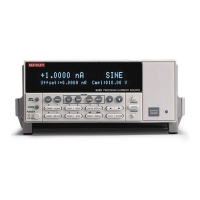Model 6220/6221 Reference Manual Applications E-11
Return to Appendix topics
Compliance overshoot prevention
Depending on range and load impedance, step changes in current could cause
the output voltage to briefly overshoot its set compliance level by as much as 2V.
This compliance voltage “glitch” will settle to the expected output voltage within
the settling time specification for the selected range. This voltage “glitch” will typi-
cally not overheat a DUT, but a few microseconds of overshoot could be enough to
damage a voltage sensitive DUT.
Overshoot is due to the current source overshooting its desired value. If the
source does not go into voltage compliance, the overshoot will decay in <1µs and
will typically not adversely affect your test or damage the DUT.
Calculating overshoot
The overshoot that typically occurs is <1V, with worse case being a maximum of
2V. The overshoot that will actually occur depends on the change in output current
relative to the full-scale current of the presently selected source range.
The following calculations for overshoot are approximations. It is assumed that the
unit is not in compliance at the beginning of the step, but then enters compliance
after the step occurs. In the calculations, the 2V term represents the maximum
overshoot that can occur.
Overshoot = (Current Step / Current Range) x 2V
For example, on the 2mA range, a 2mA step change is 100% of range and will
result in 2V overshoot:
Overshoot = (2mA / 2mA) x 2V
=2V
On the same range (2mA), a step change of 0.2mA only results in an overshoot of
200mV:
Overshoot = (0.2mA / 2mA) x 2V
= 0.1 x 2V
= 200mV
A small current step size lessens the chance of driving the source into compli-
ance. Small current steps are typically used for slow sweeps and the waveform
function. The larger step sizes are typically used for fast sweeps and the delta
tests. The delta tests generate square waves (or pulses), which have a fast rising
edge.
Test Equipment Depot - 800.517.8431 - 99 Washington Street Melrose, MA 02176 - TestEquipmentDepot.com

